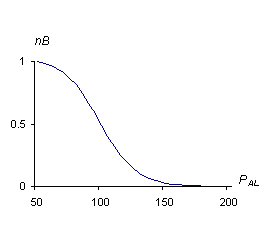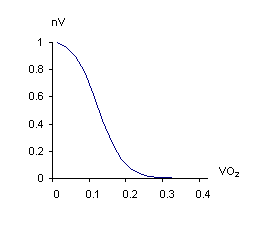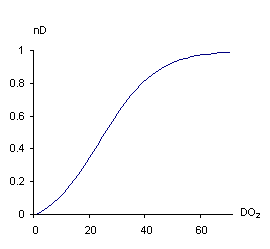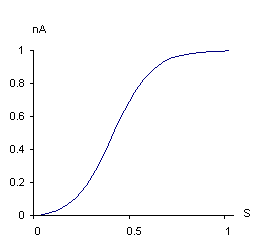|
Mathematical model > Neurohumoral control model > Receptor model
|
Receptor model
For the building of neurohumoral control model we use the neural networks theory. Receptors are formal neurons, as the input signal they receive a condition vector x (1) and vector A of dynamic system parameters. The scalar output signal r is formed by a principle of a two-level nonlinear converter. The nonlinear first-level converter convert input sygnals into scalar signal φ. The nonlinear second-level converter convert the scalar input signal φ into a fixed scalar output signal r with the help of transfer function r(φ).
|
|
|
The transfer function r(φ) is named a "receptor activity function" (receptor feedback loop characteristic) and has a standart view (48), (49).
In our model two kinds of receptors are mentioned: "positive" and "negative" depending on a kind of their activity function . The activity function of the "positive" peceptor:
 |
(48) |
The activity function of the "positive" receptor goes to zero, when values of the input signal are below threshold value φ0. Then it monotonously increases, reaching its maximal value 1 and keeps it even under big values of the input signal. The value φ0 is named a "threshold of receptor sensitivity".
The activity function of "negative" receptor:
 |
(49) |
The activity function of the "negative" receptor goes to the maximal value 1, when values of the input signal are below threshold value φ0. Then it monotonously decreases, reaching its minimal value 0 and keeps it even under big values of input signal.
In our model several kinds of receptors are considered.
Reacts to the value of arterial blood pressure.
r |
φ |
φ0 |
α |
β |
Designation of the output signal |
|---|---|---|---|---|---|
r- |
PAL |
P0 |
0.07 |
30.00 |
nB |
|
|||
|
Reacts to the value of venous oxygen concentration.
r |
φ |
φ0 |
α |
β |
Designation of the output signal |
|---|---|---|---|---|---|
r- |
VO2 |
0.00 |
30.00 |
30.00 |
nV |
|
|||
|
Reacts to the concentration value of non-oxidized metabolism products (lactic acid) in organism tissues.
r |
φ |
φ0 |
α |
β |
Designation of the output signal |
|---|---|---|---|---|---|
r+ |
DO2 |
0.00 |
0.1 |
10.00 |
nD |
|
|||
|
Reacts to the concentration value of steroid hormones (adrenalin, noradrenaline) in the blood. In the model this value is conditionally named a "stress factor" S and can take on a value 0 or 1.
r |
φ |
φ0 |
α |
β |
Designation of the output signal |
|---|---|---|---|---|---|
r+ |
S |
0.00 |
10.00 |
50.00 |
nA |
|
|||
|
The stress receptor is a general concept. In a real organism there are a lot of receptors, which react to a hormonal level. One of these receptors - beta-adrenergic receptor. A signal of stress receptor - the result of summation of various receptors signals. It means, that more complex model of the stress receptor can be submitted as a neural network.
Mathematical model > Neurohumoral control model > Receptor model
© Samara-Dialog Ltd. 2004-2009 |




